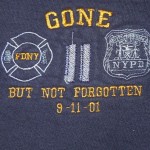Publisher’s note: This is one in a 12-part series running from Sept. 1-12 about how Lake Tahoe is tied to 9/11.
By Cindy Trigg
Sept. 11, 2001, is seared in the minds of all Americans who are old enough to remember. Often it is said that we remember where we were when it happened. Like when Kennedy was shot, when the shuttle exploded, we will never forget.
As part of the American Airline family as a flight attendant and my husband a pilot, both based in New York when it occurred, it is hard to not to forget, especially as the anniversary comes around. Just as it is hard not to forget our colleagues, although when we remember that day as a nation it’s hard not to feel like our colleagues are not remembered. There is no ill will at all toward the accolades that the first responders receive every year at this time; sometimes I just hope to hear someone say the crews’ families are also in the nations prayers.
There are interviews with passengers’ surviving relatives, with first responders’ relatives, with the relatives of the innocent victims in and around the WTC, but barely a whisper about the airline crews. My dear colleagues, flight attendants and pilots, my thoughts and prayers are with your families. I pray they have peace of mind. Always remember your family members are heroes.
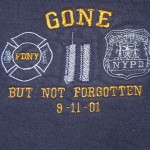
From Sept. 1-12, Lake Tahoe News is looking at 9/11.
People forget that flight attendants are the first line of defense in a hijacking, and today even more so. The pilots are now locked into the cockpit with a steel door and they tell you, you are on your own, the door cannot be opened, a crewmember will not come out.
Some of you might have heard of Betty Ong. She was one of the two flight attendants who made phone calls to the southern reservation desk who in turn reached SOC, security at American Airlines. She was able to calmly explain to the reservation supervisor what was happening. She gave them the passenger seat numbers of the men who went into the cockpit, gave them the seat number of the passenger who had had his throat slashed, and was able to let them know that one flight attendant, the purser, had been stabbed and was dying and another had been stabbed but was more stable.
Reservations wanted to know if they had called for a doctor.
The remaining flight attendants had moved the balance of first class passengers into coach because what was believed to be mace had been sprayed in the first class cabin. Then flight attendants were comforting the passengers and bringing those who needed something to drink a drink. There was no panic. They did their job and did it well even as one of their colleagues lay dying and another lay injured.
These were the flight attendants on Flight 11, the first aircraft to hit the Twin Towers. These flight attendants were able make sure the central reservation agency knew and confirmed they had been hijacked. Both flight attendants were on the phone with the ground when the aircraft hit; this after being on the phone with the ground for half an hour.
At the end, the flight attendant could be heard saying “we’re too low, we’re too low” and in the recording you can hear the people on the ground asking if they were still there after the aircraft hit the tower. This was 30 minutes prior to the second aircraft hitting the second Twin Tower. In reality it was almost one hour from the first call until the second aircraft hit. How could it be possible for anyone to remotely consider the first aircraft to be a small aircraft or an accident?
Of course there were three more aircraft that went down that day. Betty and her fellow crewmembers were the heroes who stayed calm, did their jobs and made the calls to allow the system to start working to get the rest of the aircraft out of the air. No one really knows what else was planned that morning because cockpit crews all over the United States could be told to keep their doors closed and land immediately. Other aircraft were not able to take off. These people deserve to be mentioned and thanked during every ceremony and commemorative activity that the first responders received.
Getting the call
Having been awakened by the phone ringing at 6:15am, I answered and heard the distraught voice asking, “Where’s Bill?” — all I recall is asking, “What’s wrong, what’s wrong?” while he kept asking, “Where’s Bill?” Here, I handed my husband the phone.
“Turn on the TV!” I must not have been moving quickly enough because he repeated it rather quickly and more harsh than I was used to. Together we sat there and watched with the rest of America as the second aircraft slammed into the second tower of WTC.
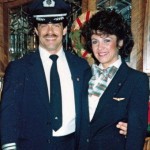
Bill and Cindy in 1999
Our first thought was of course was it an American Airlines aircraft with our crew and colleagues aboard. Sadly, we learned in a very few minutes in fact the first of the aircraft indeed was one of our own.
It is beyond comprehension that anyone in our government, especially our president, could have mistaken the first plane as a small aircraft or a “not a very good pilot” as was later reported. As I am recalling in memory of my colleagues I will not voice my political opinions, however I cannot leave out what all of America learned later. President George W. Bush was given a briefing on Aug. 6 that Osama bin Laden determined to strike in America. Later on there was confirmation that some of the chatter had indicated a hijacking. The response by Condoleezza Rice that “we thought it was only a conventional hijacking” can lead one to think that there is no value to the lives of our crew or our passengers. Only a conventional hijacking? If that were the case, where was heightened security that was implemented prior to the eve of 2000.
Bill went back to New York the first day the flying ban was lifted. That had to be one of the most fearful days I can recall. I think of the flight attendants who had to work in those early days after 911. There were opportunities to ask for the time off, but there would be no paycheck. Most flight attendants scheduled to fly did not have much of a choice if they were supporting a family. Those were heroic crewmembers.
Actually, today is no different; they are the first line of defense. My flight attendant friends say they don’t think about it unless something big happens in the Middle East, which is all too often.
Going to New York
We went to New York together about five months after the tragedy. It seemed like it was miles long, the fence that held pictures of victims, hats, memorials. What you could see of Ground Zero was devastating as it was three years later when I took three seniors from Whittell High School to New York for the Macy’s Thanksgiving Day Parade. We stayed near Ground Zero the first day. They gathered items and notes from the community to take with them and today it is in the small museum that stands at the St. Paul Chapel of the Trinity Church. From everything they received they rotate the items from around the world to acknowledge the brave and fallen. When Bill and I were there five months after the attacks, there were still the piles of ash on the grounds of the chapel cemetery. Some piles were so high it covered the head stones.
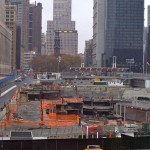
Ground Zero– New York City. Photos/Cindy Trigg
Interestingly, as close as the chapel was to Ground Zero not one piece of glass broke in the chapel. The large oak in the back entering the cemetery split in half and was the only thing on the chapel ground that was destroyed. Going back with the cheerleaders we were given a tour with the docent of the chapel. The pews in the chapel were scratched and damaged, they were going to repair them but thought it was better to leave them be as a historical marker. This is where the first responders came in and literally collapsed for moments at a time to rest. Their equipment that they wore and did not even take off is what damaged the pews. The special area and chair that President George Washington sat in for his inaugural church service was used for the first responders to sit in to soak and relax their feet. Some of their boots were melting to their feet because of the heat from Ground Zero
Tragedy continues
As it turned out, after 25 years of working as a flight attendant I never returned to American Airlines as a crewmember. At the time of 911 I was on a leave of absence for an injury sustained on the aircraft. I was conflicted on whether I wished to work again in that capacity, not because of fear, but because of my son. His dad had passed away the year before. Two months later, practically to the day, American Airlines experienced another disaster – the crash of an American Airlines AirBus 300 over New York on Nov. 12, 2001.
This was the type of aircraft my husband was flying at the time. All aircraft have tail numbers that help identify the aircraft and it’s always on the paper work. My husband had flown the aircraft that crashed on Monday morning two days earlier, on Saturday. Now, it really hit close to home. The morning of the second crash the same friend called again, “Where’s Bill, where’s Bill?” at 6:15 in the morning. Bill was in New York and I had spoken with him the night before, but it was already after 9:15 and not being quite awake it was a bit confusing.
Again Dave was saying turn on the TV. I was able to let him know right away that Bill was spending his day off in New York and that he was OK. Unfortunately, my husband was standing outside of the terminal and was able to see the plume of black smoke that suddenly came off the horizon. Briefly he hoped it was a fuel storage tank, which if you have flown out of JFK, you can see the maze of those fuel storage tanks. He said the minute he walked back inside the terminal he knew. He went to operations and as soon as the elevator door opened he knew it was an American Aircraft from the sound of the crying and the exclamations of disbelief. And then he found out that one of the best co-pilots on the “Bus” was working the flight. He had had a chance to see them that morning before they went to the aircraft and he got ready to go to the hotel.
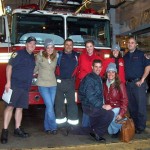
Cindy Trigg, kneeling, and Whittel cheerleaders with New York firefighters.
The phone rang all day. After calling Bill’s daughter, mother and my mother and father I reset my answering machine with an out going message, “Thank you for calling, Bill is safe, leave a message.”
It was so much more difficult because we were not together. We spoke often that day, but it was like we were all on hold, the speculation if it was another terrorist attack was rampant. It was the last thing the airline industry needed, the grief of so many families, families that were affected or killed on the ground that were first responders in the WTC attack, the worry of another attack, the delicate scab being ripped from the heart of so many who new what the pain was all about and another group of 11 colleagues as well as passengers.
Trying to cope
It is so hard not to be morbid at times. When you know what it feels like to be frightened by something you hear or feel the airplane do that you are not used to, you know how it feels to try and get out of that jump seat to peek out of that little bitty window and then everything is OK except when it is not. It is too easy to put yourself in the same position. There is only one place for a particular flight attendant to sit, same closet in front of you, same galley across from you, same first class or coach seat that you can see or not see. There are no variables, you always know where and what your colleagues were doing when you find out who was on the flight and what position they were working.
I thought 911 would be the worst I would ever see in the airline industry and I hope to God that it is. Over the 25 active years of working, there were probably more air disasters than I can think of. My first year there was the DC-10 on Memorial Day weekend in Chicago, Flight 191. The airlines usually retire a flight number when it has been in a disaster. There was the Delta flight in DFW, another 191, an American flight in Arkansas with a Check Airman, and who can forget the TWA incident that happened over the Atlantic just after take off from New York. These are just a few, and it is when it happens right after take-off or before landing that chills you because that is where we are always in the same positions.
In reality, when you take into consideration all those people who have died on our roads, it is a safe career. It is sensationalized and we see the pictures on TV over and over again. For that very reason, I could not see myself going back to working in the cabin until my son was older.
There are so many stories to tell about how wonderful this group of workers is. I will tell you one. There is a couple who fly international out of Chicago, they used fly out of Los Angeles. I remember flying many times with Ernie. They always flew in and out of Frankfurt to Chicago. During the early years of the Iraq war when our soldiers were being deployed and they started coming home for the first time, Ernie and his wife would bring a fresh roll of grass sod with them on their trip, haul it to the hotel. This is by no means a light item and they would bring it individually if they were flying by themselves. Haul it back to the aircraft for the return flight to Chicago. The agents would always let the military men and women board first. They would walk down the jet bridge and Ernie or his wife would have rolled out the sod from the jet bridge to the inside of the aircraft and they would welcome them back to American soil. I cannot tell you the stories we heard about those military men and women getting down to kiss that soil, the tears, the emotion. The agents always waited for the flight attendants to let them know they were now ready for the other passengers making sure the tears were dry and that roll of sod was now in the hands of the military men and women.
There was the crew I flew with that I will never forget when we were flying to London and Princess Diana died. We were there four days from that Sunday morning when the headlines broke until the day of her funeral. We were there with the ground crews and flight op people from London when Elton John sang and for the moment of silence. We stay at the Forum Hotel in London, which is literally right down the street from Kensington Palace. How do you forget the people you spent those kinds of days with?
Healing process
Such conflicting emotions. Do I write about the drama and the tears? But then we are so lucky to have been touched in such a minimal way? 9/11 was shocking, shocking to all America.

People who died and were involved in 9/11 came from far and near.
I still fly, travel, encourage my son to travel and travel with my family. I always pray that we are safe.
It is really funny a lot of times, in fact most of the time we speak about the aircraft in terms of “she”. It’s hard to explain, like when the crash in AK happened, watching the pictures on TV of the aircraft it was so personal. Maybe it would be the same if the building you worked in caught fire and all you could see was the shell. I still look at an airplane taking off and it’s hard to believe you can make a living in that skinny silver tube. Watching Air Force One taking off in Reno I just automatically think to myself, “OK girl, climb, climb, climb.” It is still so remarkable to me.
One thing I do know for sure, I would not trade my years as a flight attendant. I loved my career and colleagues; in fact I married one, my husband, who is still a captain with American Airlines.
When speaking about our crews it’s hard to give you an example of how we all treated each other as family. Charles Burlingame was the captain of American Flight 77 that went into the Pentagon. Before I had been on leave I was commuting from to New York from Reno usually through LA. Capt. Charles “Chick” Burlingame was one of the last pilots I flew with. On one occasion my husband and I both commuted home with him as captain. The last time I flew with him he allowed me to sit in the cockpit for take off and landing because there were no more seats. This was definitely not OK, but that was how things were before 9/11. The crews took care of each other.
Other crewmembers were family, and the cockpit crews were especially nice to those of us who were living with or married to a pilot. That was another thing, I refer to Bill as my husband throughout the story but we did not get married until March 2002. We decided to get married after 9/11 and the crash in New York in November. We had been together for 13 years, had accumulated some real estate and had other investments. We did not want our families to have to sort things out if anything happened. I tease and tell him I finally decided to say yes, actually he was the one who finally relented. It’s hard to explain why we finally actually got married. Of course we had loved each other for many years, but each having our own children it did not seem necessary. There was a sense of wanting to know that we were together, wanting to know there was an “ever after.”
The crash in New York was too close to home and the realization hit hard that it is quite possible that it could be our own loved ones. The odds go up when you do it for a living, but you really never think about it, at least not before 9/11 or the crash on Nov. 12.
Since 9/11, when I fly standby, which is the only way I fly, I do not get the least upset about missing a flight or getting bumped. If I belong on the flight, I will get on, if not, grab a good book and wait for the next flight. If I get home, I get home. If I have to spend the night, I spend the night even if it means sleeping in the airport, which is really not so bad with a good book and a big coat.
I was very proud of the job we did and I still miss it every day. And I was never as proud as I was of my colleagues as I was on 9/11. I always knew we were trained well and always knew they would do their best under the most extreme conditions. Unfortunately, they had an opportunity to prove me right.
Please remember these heroes when we commemorate the 10-year anniversary. If you’re traveling at that time, let your crewmembers know their friends were heroes, too.
Cindy Trigg lives with her husband, Bill, in Stateline.


